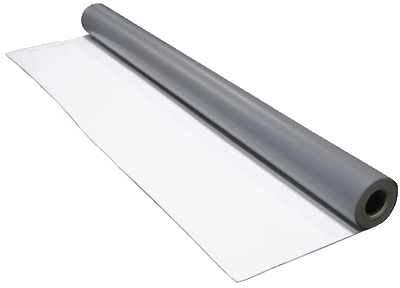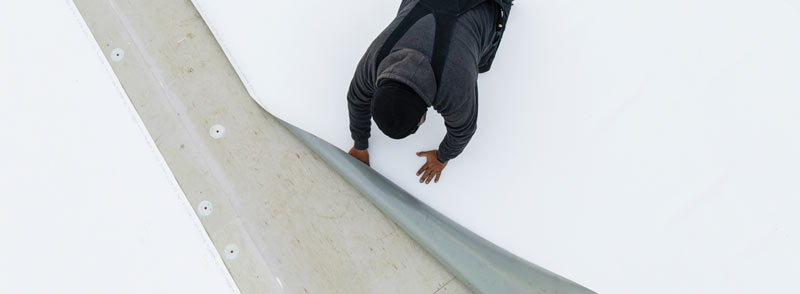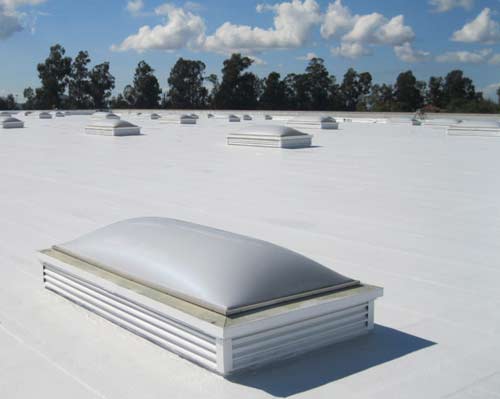Thermoplastic Polyolefin (TPO) Roofing
Commercial Roofing Contractor Serving Bradenton and Sarasota
As a relative newcomer to the commercial roofing industry, TPO has quickly become one of the most popular choices in single-ply roofing materials. Developed in the 1990s and created from a blend of ethylene, propylene, rubber and fiberglass, TPO’s benefits make it an ideal material for Florida roofs.
Benefits of TPO
- UV resistance TPO’s white reflective exterior makes huge contributions to saving money on energy bills. The roofing material reflects sunlight off of the roof, keeping the building cooler as well as allowing the AC system to exert less energy. This saves money on energy bills and helps to extend the life of the AC system.
- Oil, acid and chemical resistance Restaurants and other food and beverage preparation facilities tend to emit oils, fats and more from the ventilation system, which is typically located on the roof. Many types of roofing materials can be broken down by such substances, but TPO’s resistance to them makes it ideal for restaurant roofing.
- Flexibility Since TPO’s rubber and fiberglass composition is strong and flexible, it’s highly resistant to punctures, tears and impact damage, making it well-suited to protect the building. The material’s flexibility also makes it resistant to thermal shock from temperature fluctuations, so the roof itself is not likely to crack and can be expected to last much longer than other materials.
- Wind resistance The application methods available for TPO roofing paired with its smooth finish create a protective surface that resists high winds and wind uplift. Since a finished TPO roof is virtually seamless, it’s nearly impossible for wind to penetrate and lift off the roof, a problem commonly recognized in asphalt shingle roofs.
- Resistant to bacteria, mold & algae growth Single-ply roofing membranes are inherently resistant to fungal growth, meaning that a large concern can be avoided at the outset by simply choosing the right material.
- Fire-resistant TPO’s rubber composition means it’s naturally resistant to fire, an added benefit contributing to both the safety of the building and potentially lower insurance rates.
- Environmentally friendly TPO is Energy-Star rated and is considered a green building material. The material contains no chlorine, will not deposit contaminants into runoff/groundwater and is 100% recyclable after it has reached the end of its useful life. The energy savings of TPO roofing can benefit the community by helping to reduce the urban heat island effect as well.
Application Methods
TPO roofs are suitable for residential, commercial and industrial-use buildings in a variety of slopes and can be installed using a variety of application methods:

- Mechanically attached The membrane is attached to the substrate using fasteners. The sheets are overlapped at the edges, covering the fasteners, and then hot-air welded together to create a permanently fused, fully-closed seam that is sealed with an edge sealant as the final step. Mechanical fasteners are typically more lightweight and lower in cost than bonding adhesive.
- Fully adhered The membrane is glued to the substrate using a specifically designed adhesive that chemically bonds with the membrane and becomes elastomeric as it dries. This method is typically ideal for roofs with unusual configurations.
- Ballasted The membrane is sealed at the edges and all of the roof’s penetrations and protrusions and held down by a layer of ballast (smooth river-washed stones) or concrete pavers. This method is much heavier and is chosen less frequently than other methods due to the added stress it puts on the building’s structure. The loose rocks can also clog the roof’s drains, causing pooling and leading to potential damage to the roof.
The application method used depends on the type of roof as well as the typical weather conditions in the geographical area in which the building lives. Moreover, TPO seams are typically 3–4 times stronger than the adhesive and taped seams of EPDM roofing membranes. Properly applied and maintained, TPO roofs can be expected to last up to 20 years. Ask about 10, 15 or 20-year manufacturer’s warranties on TPO roofing systems.
Specifications
TPO comes in a variety of colors, widths and thicknesses.

- Colors TPO roofing membranes are typically available in white, gray or black, with white being the most UV reflective and black being the most UV absorbent.
- Widths The width and length of TPO sheets can vary depending on the manufacturer, but typically they come in sheets that are 6–6.5’ wide for residential application and 3–12’ wide for commercial use. The widths can be customized to fit the specifications of the job.
- Thicknesses TPO sheets are available in thicknesses of 45, 60, 75 and 90 mils, with 60 mils (.06”) being the most common.
Pricing varies depending on the specifications, materials and application methods chosen, but TPO roofing is typically priced reasonably about halfway between EPDM and PVC roofs.

Contact Us Today!
If you are in need of a knowledgeable roofing contractor that specializes in tpo roofs, the industry-leading team at AKVM can help. We offer competitive pricing, financing options, and free in-person evaluations and quotes. Contact us with any questions you may have, we will be happy to assist you.